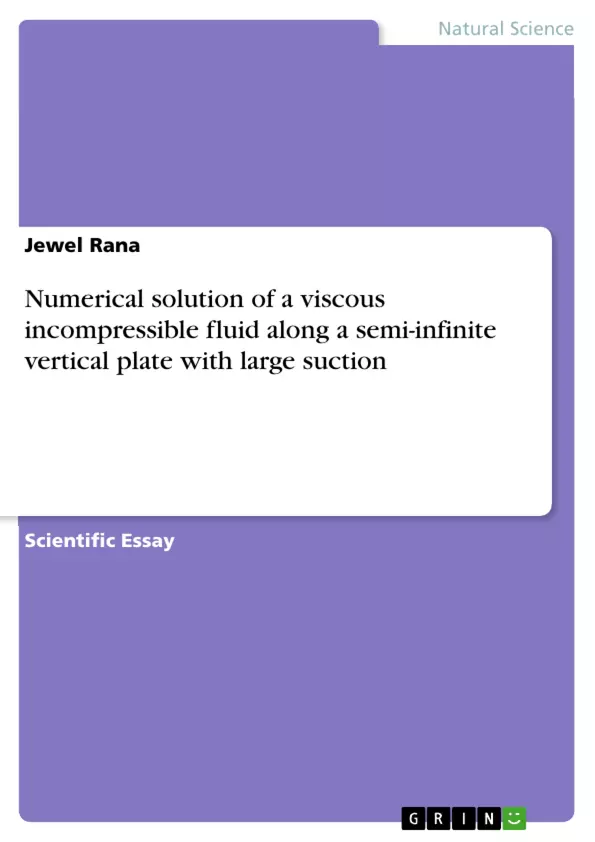Velocity profile and temperature distribution of a viscous incompressible fluid along a semi-infinite vertical plate with large suction is investigated in this work. The governing equations are solved numerically using perturbation technique. The flow phenomenon has been characterized with the help of flow parameters such as Suction parameter , Prandtl number and Eckart number .The effects of these parameters on the velocity field and temperature distribution have been studied and the results are presented graphically and discussed quantitatively. This type of problem is significantly relevant geophysical and astrophysical studies.
Inhaltsverzeichnis (Table of Contents)
- Chapter One: Introduction
- Chapter Two: Numerical Solution of a viscous incompressible fluid along a semi-infinite vertical plate with Large Suction
- 2.1 Mathematical Model of Flow
- 2.2 Mathematical Formulation
Zielsetzung und Themenschwerpunkte (Objectives and Key Themes)
This work investigates the velocity profile and temperature distribution of a viscous incompressible fluid along a semi-infinite vertical plate with large suction. The governing equations are solved numerically using a perturbation technique. The study focuses on the influence of various flow parameters, such as suction parameter, Prandtl number, and Eckart number, on the velocity field and temperature distribution. The results are presented graphically and discussed quantitatively. This problem is significant for geophysical and astrophysical studies.
- Heat transfer and mass transfer in viscous incompressible fluids
- Numerical solution of boundary layer flow problems using perturbation techniques
- Impact of suction on velocity and temperature distribution
- Influence of flow parameters, including Prandtl number and Eckart number
- Applications in geophysical and astrophysical studies
Zusammenfassung der Kapitel (Chapter Summaries)
Chapter One introduces the problem of boundary layer flows on moving solid surfaces, emphasizing the importance of heat transfer in various engineering applications. It reviews existing research on free convection boundary layer flow over various shapes, highlighting the role of suction in boundary layer control. The chapter sets the stage for the investigation of heat and velocity transfer of a viscous incompressible fluid along a thermal boundary layer with large suction.
Chapter Two delves into the numerical solution of the problem. It presents the mathematical model of the flow, establishing the governing equations and boundary conditions. The chapter then introduces the stream function and uses it to transform the governing equations into a dimensionless form. This transformation allows for a more convenient and efficient numerical solution.
Schlüsselwörter (Keywords)
The main keywords and focus topics of the text include: heat transfer, mass transfer, accelerated plate, suction, perturbation technique, viscous incompressible fluid, boundary layer flow, velocity profile, temperature distribution, Prandtl number, Eckart number, geophysical studies, astrophysical studies.
- Arbeit zitieren
- Jewel Rana (Autor:in), 2015, Numerical solution of a viscous incompressible fluid along a semi-infinite vertical plate with large suction, München, GRIN Verlag, https://www.grin.com/document/294724



